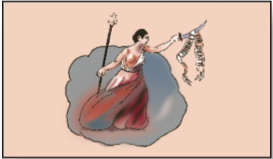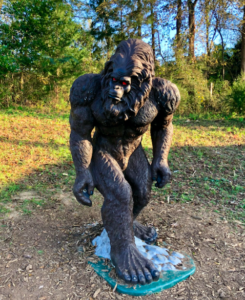Skip to content

There are two things that are guaranteed to bring a smile to a Texan’s face: The Lone Star Flag and bluebonnets. And as anyone who travels knows, the flag and outline of the state of Texas are symbols recognized around the world. We wouldn’t have it any other way.
The Lone Star Monument and Historical Flag Park in Conroe is an “outdoor museum” dedicated to sharing part of the st ory of the Texas Revolution. Its location is especially appropriate because Montgomery County is the birthplace of the Lone Star Flag that was voted and settled on by the Texas congress in 1839.
ory of the Texas Revolution. Its location is especially appropriate because Montgomery County is the birthplace of the Lone Star Flag that was voted and settled on by the Texas congress in 1839.
 At the entrance to the display is a five-foot tall granite pedestal topped by a bronze bust of Dr. Charles B. Stewart, who is credited with creating the design for our beloved State Flag of Texas. The artist, Craig Campobella, created the image from the only surviving photograph –and it was a blurry one – of the doctor.
At the entrance to the display is a five-foot tall granite pedestal topped by a bronze bust of Dr. Charles B. Stewart, who is credited with creating the design for our beloved State Flag of Texas. The artist, Craig Campobella, created the image from the only surviving photograph –and it was a blurry one – of the doctor.
Stewart also served as an interpreter between General Sam Houston and General Santa Anna at the Battle of San Jacinto, signed the Texas Declaration of Independence and was Texas’ first Secretary of State.
 Follow the path from the Stewart memorial up to the flag park, and you’ll be greeted by another bronze artwork, the 14-foot bronze statue standing in the center of the circle of flags. Named The Texian (a fighter in the Texas Revolution), the charging subject is brandishing the version of the Lone Star flag that appeared in the Republic of Texas three years after the Battle of San Jacinto.
Follow the path from the Stewart memorial up to the flag park, and you’ll be greeted by another bronze artwork, the 14-foot bronze statue standing in the center of the circle of flags. Named The Texian (a fighter in the Texas Revolution), the charging subject is brandishing the version of the Lone Star flag that appeared in the Republic of Texas three years after the Battle of San Jacinto.
And symbolism? It’s packed full!
13 rocks under the Texan’s left foot represent the 13-day long siege at the Alamo. And imagine how long it took the artist to make 354 marks on the rocks to memorialize each soldier massacred at Goliad.
Look for clues in the soldier’s clothing, too. 18 buttons on his shirt, coat and pants stand for the number of minutes the fighting went on at San Jacinto. His red sash is a signature of the Texas Army whose members tied them on the right hip when every other army tied them on the left.
View his tie and sash from the five o’clock position and you’ll see that they incorporate the Alpha and Omega, the beginning and the end, referring to the 5 p.m. hour on April 21, 1836 when the Battle of San Jacinto came to an end.
The nine Texians who died at San Jacinto are remembered with nine stones under the right boot.
This time of year, the mound that The Texian stands atop is planted in brilliant bluebonnets, making it especially delightful to see.

Lift your gaze and you’ll see a circle of flags flying overhead. Flags were used to communicate the spirit and identities of the brave people who battled for Texas independence. And although the six national flags that ha ve flown over Texas are more commonly known, many more have been carried in the Lone Star State. In fact, when the organizers of the park decided to fly 13 different flags to symbolize the 13 colonies of Texas at the time of the 13-day siege at the Alamo, they had to make their choices from over 50 flags!
ve flown over Texas are more commonly known, many more have been carried in the Lone Star State. In fact, when the organizers of the park decided to fly 13 different flags to symbolize the 13 colonies of Texas at the time of the 13-day siege at the Alamo, they had to make their choices from over 50 flags!
The story behind each of these 13 flags is displayed on a bronze plaque at the base of its 35-foot flagpole.

Coahuila Y Tejas 1821-1836

1824 Tri-color Alamo Flag 1835-1836

Texas Navy Flag 1836

Alabama Red Rovers 1835-1836

New Orleans Grays 1835-1836

Gonzales Flag 1835 Come and Take It

Sarah Dodson’s Tri-color Flag 1835

Troutman Lone Star Flag 1836

Goliad Flag, Severed Arm, Bloody Sword 1836

San Jacinto Liberty Flag 1836

First Flag of the Republic De Zavala Flag 1836

Second Flag of the Republic Burnet Flag 1836

Lone Star Flag 1839

You’ll find the Lone Star Monument and Historical Flag Park adjacent to the Montgomery County Library, at 104 I-45 North in Conroe. The park is free to visit and open seven days a week.


For my 11th birthday, my parents took a group of my friends and I to see a new movie: “The Legend of Boggy Creek- A True Story.”
If you need a good giggle, click here to see the original movie trailer.

It was a new scary movie (called a docu-drama) about a monster that lived in the swamps of Arkansas. (I know, I know…”swamps in Arkansas?”) Basically portrayed as a Bigfoot-like creature, this guy attacked and killed people. I remember not being very scared (even back then it took quite a bit to scare me), but my friends screamed and clutched each other through the entire thing. I don’t remember if I noticed that it was painfully obvious that this “Bigfoot” was a guy in an ape suit, complete with cutout eyes.
But as bad as it was, the movie holds a fun spot in my memories because, hey…it was my birthday.
 Just a few months ago I was speaking at a paranormal convention in Jefferson (about Victorian funeral customs). One of the gentlemen who had a booth in the vendor hall carried just about everything Bigfoot-themed you could think of: dolls, bumper stickers, books, key chains and more. I resisted as long as I could, but I finally politely asked him what connection Bigfoot had with East Texas.
Just a few months ago I was speaking at a paranormal convention in Jefferson (about Victorian funeral customs). One of the gentlemen who had a booth in the vendor hall carried just about everything Bigfoot-themed you could think of: dolls, bumper stickers, books, key chains and more. I resisted as long as I could, but I finally politely asked him what connection Bigfoot had with East Texas.
He looked at me as if I had lost my mind, and then asked if I had ever heard of a movie called “Legend of Boggy Creek.”
I smiled and replied that, well yes as a matter of fact I remembered that movie.
That’s when he told me that although the movie was set in Arkansas, those events actually happened in East Texas, where Bigfoot has been seen for years.
 A couple of other attendees gathered to tell me that OF COURSE it was about East Texas, and the movie had even been filmed there.
A couple of other attendees gathered to tell me that OF COURSE it was about East Texas, and the movie had even been filmed there.
Well, huh. Who knew?
I thanked them for the information, and sat myself down for a visit with Mr. Google. But all I really had to do was walk across the street from the convention area to see a bronze statue of Bigfoot.
The next day, I drove to Uncertain, which is appropriately named for anything spooky, and recognized the same type of swampy, cypress-filled waterways and run-down wooden shacks that appeared in the movie.

I didn’t get to meet Bigfoot, but maybe he rests during the day. Wherever he was, I found Uncertain to be a magical place, and can’t wait to visit again to go kayaking or on an airboat ride. It’s an ecological wonderland. But I’ll have to remember to keep an eye out for the Big Guy in the treeline.
Who wants to join me?



_ . _.._ ._ …
If it looks like I just accidently hit some random keys while beginning to type this, morse code might not be in your wheelhouse. The mysterious string of dots and dashes spells out the name of a place I love: Texas!
On 100 block of North Washington street in Marshall, facing their enormous courthouse, this life size bronze statue reminds passersby that the town holds a unique place in communication history. It sits on the spot where the first telegraph office in the state opened in February 14, 1854. Long-distance communication w-a-y before cellphones and emails made it something that we take for granted.

The Texas and Red River Company opened its Marshall office and strung wires all the way to Shreveport, which in turn had wires to New Orleans. By 1854 another line connected the town to Houston via other lines. That opened up a lot of business opportunities for the railroad town.
By 1870 there were about 1,500 miles of telegraph wire across the Lone Star State. Instead of riders on horseback an stagecoach carrying  handwritten messages for days, a series of sounds could be translated into words and handed to messenger boys as young as 10 years old who would deliver the messages on their bikes within minutes.
handwritten messages for days, a series of sounds could be translated into words and handed to messenger boys as young as 10 years old who would deliver the messages on their bikes within minutes.
Now here’s the part that’ll leave you scratching your head…
In 1838, Samuel F. B. Morse (the inventor of the telegraph) wrote a letter to Memucan Hunt. Hunt was a friend of Morse’s who just happened to be the Republic of Texas minister to the United States who had told the inventor countless stories about Texas. He had explained that although the republic had lots of land and heart…it was a bit short on revenue.

In the letter, Morse offered the answer to that problem by GIVING the rights to his incredible invention to Texas. Um, WHAT?!
 Somehow the letter, which had been forwarded to officials of the republic, ended up filed away, gathering dust.
Somehow the letter, which had been forwarded to officials of the republic, ended up filed away, gathering dust.
Y-e-a-r-s later in 1860, Morse wrote a follow up letter to Texas Governor Sam Houston.
“In the year 1838 I made an offer of gift of my invention of the Electro magnetic Telegraph to Texas … Although the offer was made more than twenty years ago, Texas … has never directly or impliedly accepted the offer. I am induced, therefore, to believe that in its condition as a gift it was of no value to the State … I, therefore, now respectfully withdraw the offer made then.”
Wow, talk about an opportunity falling through the cracks! Imagine how much money Texas could have made as the owner of that patent. Sigh…
So while this beautiful bronze statue reminds us of an immense accomplishment…there is definitely a “oops” factor attached!

 ory of the Texas Revolution. Its location is especially appropriate because Montgomery County is the birthplace of the Lone Star Flag that was voted and settled on by the Texas congress in 1839.
ory of the Texas Revolution. Its location is especially appropriate because Montgomery County is the birthplace of the Lone Star Flag that was voted and settled on by the Texas congress in 1839. At the entrance to the display is a five-foot tall granite pedestal topped by a bronze bust of Dr. Charles B. Stewart, who is credited with creating the design for our beloved State Flag of Texas. The artist, Craig Campobella, created the image from the only surviving photograph –and it was a blurry one – of the doctor.
At the entrance to the display is a five-foot tall granite pedestal topped by a bronze bust of Dr. Charles B. Stewart, who is credited with creating the design for our beloved State Flag of Texas. The artist, Craig Campobella, created the image from the only surviving photograph –and it was a blurry one – of the doctor. Follow the path from the Stewart memorial up to the flag park, and you’ll be greeted by another bronze artwork, the 14-foot bronze statue standing in the center of the circle of flags. Named The Texian (a fighter in the Texas Revolution), the charging subject is brandishing the version of the Lone Star flag that appeared in the Republic of Texas three years after the Battle of San Jacinto.
Follow the path from the Stewart memorial up to the flag park, and you’ll be greeted by another bronze artwork, the 14-foot bronze statue standing in the center of the circle of flags. Named The Texian (a fighter in the Texas Revolution), the charging subject is brandishing the version of the Lone Star flag that appeared in the Republic of Texas three years after the Battle of San Jacinto.
 ve flown over Texas are more commonly known, many more have been carried in the Lone Star State. In fact, when the organizers of the park decided to fly 13 different flags to symbolize the 13 colonies of Texas at the time of the 13-day siege at the Alamo, they had to make their choices from over 50 flags!
ve flown over Texas are more commonly known, many more have been carried in the Lone Star State. In fact, when the organizers of the park decided to fly 13 different flags to symbolize the 13 colonies of Texas at the time of the 13-day siege at the Alamo, they had to make their choices from over 50 flags!





























